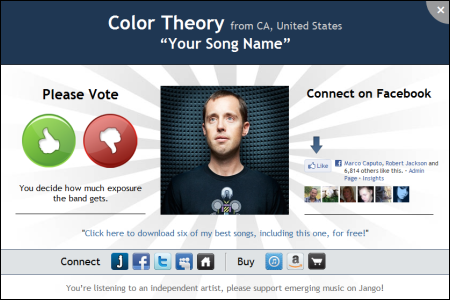
Jango offers free Pandora-style internet radio. Type in an artist’s name and it generates a playlist of related songs. Jango Airplay lets artists buy their way into the recommendation engine, promising guaranteed airplay alongside your pick of big names.
I’ve been running Jango campaigns pretty much continuously since the service launched in March of 2009. My songs have been played 270,000 times, 23% of which were unpaid “organic” plays. It cost me $1841.50 out of my own pocket, plus at least that much in affiliate earnings from my previous articles on the topic.
What’s my return on that investment? There’s no way to know.
Jango reports 25,000 likes and 9800 fans, but those terms have little meaning. A like on Jango is a simple thumbs-up that has nothing to do with Facebook, and most of those “fans” are unreachable. An average of one email address per day has been shared with me since that feature launched in early 2010, but those 700 email addresses alone don’t justify the expense.
The reason I stick with it is because I’ve seen so many Jango listeners become genuine fans. They friend me on Facebook, reply to my email updates, comment on my YouTube videos, and yes, buy my music. With the possible exception of Facebook Ads, I’m convinced Jango is the best passive promotion out there.
Others are skeptical. My blog’s top Google search term is “jango airplay scam.” Some suggest that while the service does what it claims to do, any form of pay-for-play is payola (I address that argument here). Conspiracy theorists claim that the entire service is a fraud, and that the comments and realtime listener feed are faked (despite the fact that many comments clearly apply to a particular song, and that you can message listeners directly from the feed).
Jango could go a long way towards dispelling these concerns by finally fixing the weakest aspect of the service: artist-to-fan communication.
When I send out a mass email to 9800 fans, I typically get only one or two responses. With a response rate of 0.0002%, it’s natural to wonder if anyone is really out there.
The problem is that the listener’s inbox is tucked away in a drop-down menu. The vast majority of Jango users almost certainly don’t realize they have an inbox.
I suggest Jango eliminate all social networking features and share new fans’ email addresses by default, unless a box is unchecked. Then add a full-featured fan management system like ReverbNation’s FanReach, with an export function and full analytics including open and clickthrough rates.
While I’m making suggestions, I’d love to see a percentage of likes for each song, which would make it easy to tell the hits from the misses, and simplify running a focus group.
To their credit, Jango has added plenty of new features since I first wrote about it. Highlights include:
1. Custom promo module. You can now choose exactly what listeners see when your song plays. I’m using the “Facebook Likes” module, which connects directly to my Facebook page. It also includes a custom text link, plus icon links to web profiles and stores (you can see it at the top of this post).
2. Band Central. A new mini-site showcasing Airplay artists, sorted by genre, geography, or “popularity.” You’d think popularity would mean the number of fans, but it’s actually based on PopScore: a much-maligned metric of quality algorithmically derived from fan response.
3. The Jango Airplay Blog and how-to support links. The staff is much more accessible and social, and the site’s inner workings more transparent, than when the service first launched. The blog and how-to’s are full of tips and strategies, plus contests and weekly top 10’s. For example, one post walks you through creating a spoken audio intro for your songs. Great idea!
4. Royalties. This isn’t exactly a feature, but after much speculation I can now confirm that Jango does pay royalties. I received a whopping $13.23 from Jango via SoundExchange last quarter. Based on that low figure, my guess is that they only pay royalties on free “organic” plays, not paid plays through the Airplay program. Hey, it’s more than I got from Last.fm!
Though there’s still plenty of room for improvement, Jango is better than ever. I’ll continue to report back with my results, recycling all money earned through my affiliate link into plays.
Brian Hazard is a recording artist with seventeen years of experience promoting his ten Color Theory albums. His Passive Promotion blog emphasizes “set it and forget it” methods of music promotion. Brian is also the head mastering engineer and owner of Resonance Mastering in Huntington Beach, California.